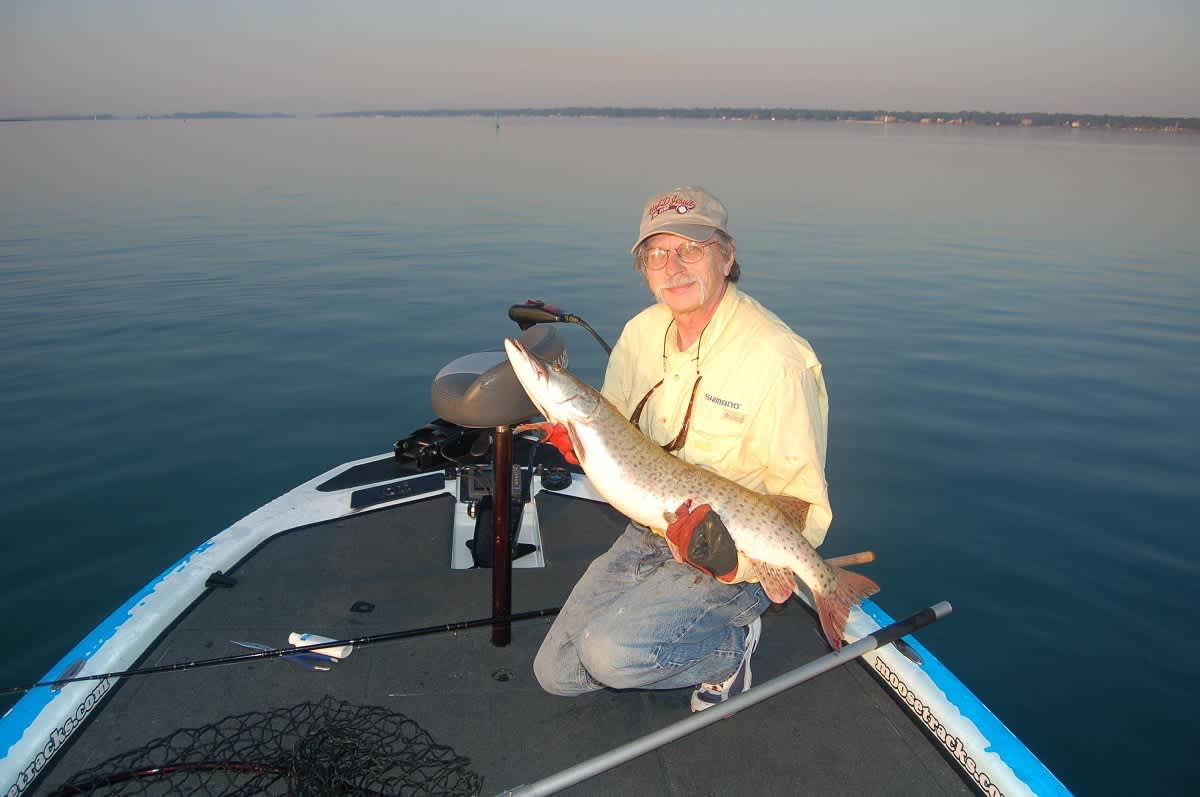Get Ready for Lake St. Clair and Detroit River Muskies
Bob Gwizdz 06.01.15

The last significant opening day of fishing season in Michigan, the opening day for muskellunge in Lake St. Clair, the St. Clair River, and the Detroit River, arrives the first Saturday of June. Because the water drains from Lake Huron, which is cold, through the St. Clair River, the spawning season is delayed and Lake St. Clair and its connecting waters open more than a month later than the rest of the state (the Ontario waters of the lake and rivers open the same day, too).
Lake St. Clair is an outstanding muskellunge fishery. Last year, of the 30 muskies entered in the Department of Natural Resources’ Master Angler program (which requires that entries have a minimum length of 42 inches), 22 were caught in Lake St. Clair and connecting waters.
The bulk of muskie fishing in Lake St. Clair is trolling. Anglers drag body baits and bucktails, usually pretty high in the water column, in as deep of water as they can find. Don Miller, who runs Muskie Mania Charters and has been fishing Lake St. Clair for muskies for more than 30 years, says Anchor Bay on the massive lake’s northwest corner is the place to open the season.
“Key in on that area out in front of Grassy Island in nine to 11 feet of water,” Miller said. “I would run my baits four or five feet down to start and by late afternoon as the water heats up, most of the action is going to take place in the top couple of feet of water. I never run my baits more than halfway down the water column.”
Miller also recommends the New Baltimore area off Selfridge Air Force Base. “There’s a shelf out there off the drop-off,” Miller said. “The fish like stage there on the deeper side in eight to 10 feet of water.
“I’ve had some phenomenal catches out in front of the Salt River,” he continued. “Any of those creeks that pour in out there bring warmer water into the lake and it often creates a color line where those fish like to hold. In front of the Clinton River by the A Marker has a good weed bed. There are plenty of muskies staging right in there off that weed line. And there are lots of nice muskies out in front of Black Creek off Metro Beach. The area between Black Creek and the Middle Channel holds some nice fish. The spillway area has some nice fish in there in early season, too.”
Further down the lake, the Dumping Grounds just up from the Detroit River is good, Miller said.
“That area in the Detroit River off Belle Isle is one of the best spawning areas and those bigger girls will be coming off their beds in the river off Belle Isle and moving up in there. Peche Island, at the head of the river, is right off the tip of the Dumping Grounds. Fish off the range markers anywhere between seven to 10 feet of water and you’re going to find some fish.”
Miller recommends trolling relatively near the boat.
“Run those baits about 20 feet back with two or three ounces of in-line weight,” he said. “I’ve always had better luck with the smaller baits early in the season—six- or seven-inch baits. I like Believers, Wileys, and Lokes, but I wouldn’t overlook spoons. The Eppinger Juniors are good. I have had them hit the larger ones but it seems like they miss the hook sometimes. With the smaller spoons it seems like they get the whole thing when they hit it.”
For anglers who prefer not to troll, veteran Lake St. Clair fishing guide Kevin Long says both casting and jigging will produce. He likes Anchor Bay for casting bucktails and glider bait—Phantoms and Hellhounds—around the beds, but says he has heard plenty of guys say they do well with spinnerbaits, too.
But Long says the best bet early in the season is in the Detroit River.
“Early in the season I don’t fish the St. Clair River very much because the water is still too cold,” he said. “But the Detroit River is warmer and it holds fish all the way from the Trenton Channel up to the lake.”
Long says he starts out casting early in the morning—he runs bucktails pretty fast but fishes gliders on a medium retrieve—near any kinds of weeds or rocky cover. But once the sun gets up, he backs off into deeper water.
“I like to bounce bottom with jigging baits, like the Bondy Bait,” Long said. “Cover lots of water—those fish can be anywhere.
“Drop that bait down to the bottom and point your rod tip at the water,” he explained. “Then when you pick it up, move the rod tip so your rod is parallel with the water’s surface, so you’re moving that bait about three feet. Don’t raise that rod too high because you’ll be going along doing nothing and all of a sudden that fish will hit and if you’ve got your rod too high, you’ll never be able to set the hook.
“You’ll have to be constantly adjusting—letting out line or reeling in a little—because the bottom is uneven and you want to stay in contact with the bottom.”
Long says he uses heavy-duty, multi-strand steel leaders when jigging, but prefers heavy fluorocarbon leaders for casting.
“They seem to hit those baits casting better with fluorocarbon than with steel leaders,” he concluded. “But with jigging, I stay with steel.”
For more information on Michigan fishing go to michigan.org. Click here to purchase a Michigan fishing license online.
This article was produced in partnership with Pure Michigan.

